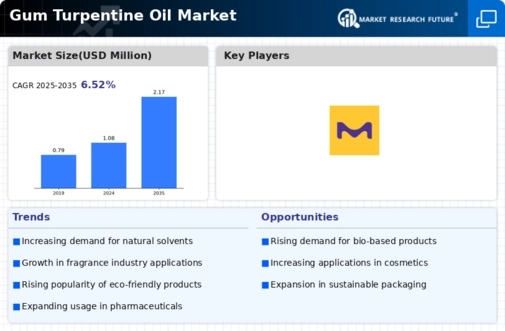-
EXECUTIVE SUMMARY 15
-
GLOBAL GUM TURPENTINE OIL MARKET, BY TYPE 17
-
GLOBAL GUM TURPENTINE OIL MARKET, BY APPLICATION 18
-
GLOBAL GUM TURPENTINE OIL MARKET ATTRACTIVENESS ANALYSIS, BY REGION 18
-
MARKET INTRODUCTION 19
-
DEFINITION 19
-
SCOPE OF THE STUDY 19
-
MARKET STRUCTURE 20
-
RESEARCH METHODOLOGY 21
-
RESEARCH PROCESS 21
-
PRIMARY RESEARCH 22
-
SECONDARY RESEARCH 23
-
MARKET SIZE ESTIMATION 23
-
TOP-DOWN AND BOTTOM-UP APPROACH 24
-
FORECAST MODEL 25
-
LIST OF ASSUMPTIONS & LIMITATIONS 26
-
MARKET DYNAMICS 27
-
INTRODUCTION 27
-
DRIVERS 28
- SUSTAINED DEMAND FROM THE PERFUMERY AND FRAGRANCE INDUSTRY 28
- CONTINUED DEMAND FROM THE PAINTS & COATING INDUSTRY 29
-
RESTRAINTS 31
- PRESENCE OF ALTERNATIVES TO TURPENTINE OIL 31
-
OPPORTUNITIES 32
- THE SUSTAINABILITY FOCUS OF THE PINE-CHEMICALS INDUSTRY IS IN LINE WITH THE RISING DEMAND FOR ENVIRONMENTAL-FRIENDLY INGREDIENTS 32
- RISING NUMBER OF TAPPERS IN DEVELOPING COUNTRIES TO GENERATE INCREASED REVENUES IN THE MID-TERM FORECAST PERIOD 32
- CASCADING USAGE OF BIOMASS AND A STRONG FOCUS ON R&D IN THE SUPPLY CHAIN 33
-
CHALLENGES 34
- PINE & TAPPER AVAILABILITY AND GOVERNMENT REGULATIONS AROUND IT 34
-
MARKET FACTOR ANALYSIS 35
-
SUPPLY CHAIN ANALYSIS 35
- RAW MATERIAL SUPPLIERS 36
- GUM TURPENTINE OIL MANUFACTURERS 37
- DISTRIBUTION & SALES CHANNEL 37
- APPLICATION 37
-
PORTER''S FIVE FORCES ANALYSIS 38
- THREAT OF NEW ENTRANTS 38
- BARGAINING POWER OF SUPPLIERS 39
- THREAT OF SUBSTITUTES 39
- BARGAINING POWER OF BUYERS 39
- INTENSITY OF RIVALRY 40
-
PRICING ANALYSIS (USD/TON), BY REGION, 2019–2021 40
-
IMPACT OF COVID 19 OUTBREAK ON GUM TURPENTINE OIL MARKET 40
- IMPACT OF COVID-19 ON THE SUPPLY CHAIN OF GUM TURPENTINE OIL 40
- IMPACT OF COVID-19 ON GUM TURPENTINE OIL INDUSTRY 42
-
GLOBAL GUM TURPENTINE OIL MARKET, BY TYPE 44
-
OVERVIEW 44
-
WOOD TURPENTINE 46
-
SULPHATE TURPENTINE 47
-
FAT TURPENTINE 48
-
CARBONIZATION TURPENTINE 49
-
GLOBAL GUM TURPENTINE OIL MARKET, BY APPLICATION 50
-
OVERVIEW 50
-
ADHESIVES & SEALANTS 52
-
RUBBER 53
-
PAINTS & COATINGS 54
-
PERFUMES/ FRAGRANCES 55
-
PHARMACEUTICAL PRODUCTS 56
-
OTHERS 57
-
GLOBAL GUM TURPENTINE OIL MARKET, BY REGION 58
-
OVERVIEW 58
-
NORTH AMERICA 61
- US 63
- CANADA 65
-
EUROPE 68
- GERMANY 71
- RUSSIA 73
- ITALY 75
- FRANCE 77
- SPAIN 79
- UK 81
- REST OF EUROPE 83
-
ASIA PACIFIC 85
- CHINA 88
- INDIA 90
- JAPAN 92
- AUSTRALIA & NEW ZEALAND 94
- SOUTH KOREA 96
- REST OF ASIA-PACIFIC 98
-
LATIN AMERICA 100
- BRAZIL 103
- MEXICO 105
- ARGENTINA 107
- REST OF LATIN AMERICA 109
-
MIDDLE EAST & AFRICA 111
- TURKEY 114
- SOUTH AFRICA 116
- GCC COUNTRIES 118
- ISRAEL 120
- REST OF MIDDLE EAST & AFRICA 122
-
COMPETITIVE LANDSCAPE 124
-
MARKET INTRODUCTION 124
-
KEY DEVELOPMENTS 124
-
GLOBAL MARKET STRATEGY ANALYSIS 124
-
COMPETITIVE BENCHMARKING 125
-
COMPANY PROFILES 126
-
HTPL (HIMACHAL TEREPENE PRODUCTS PRIVATE LIMITED) 126
- COMPANY OVERVIEW 126
- FINANCIAL OVERVIEW 126
- PRODUCTS OFFERED 126
- KEY DEVELOPMENTS 126
- SWOT ANALYSIS 127
- KEY STRATEGIES 127
-
PRIVI SPECIALITY CHEMICALS LIMITED 128
- COMPANY OVERVIEW 128
- FINANCIAL OVERVIEW 128
- PRODUCTS OFFERED 129
- KEY DEVELOPMENTS 129
- SWOT ANALYSIS 129
- KEY STRATEGIES 129
-
MERCK KGAA (MERCK) 130
- COMPANY OVERVIEW 130
- FINANCIAL OVERVIEW 130
- PRODUCTS OFFERED 131
- KEY DEVELOPMENTS 131
- SWOT ANALYSIS 131
- KEY STRATEGIES 131
-
MENTHAALLIED (MENTHA & ALLIED PRODUCTS PRIVATE LIMITED) 132
- COMPANY OVERVIEW 132
- FINANCIAL OVERVIEW 132
- PRODUCTS OFFERED 132
- KEY DEVELOPMENTS 132
- SWOT ANALYSIS 133
- KEY STRATEGIES 133
-
PUNJAB ROSIN AND CHEMICALS WORKS 134
- COMPANY OVERVIEW 134
- FINANCIAL OVERVIEW 134
- PRODUCTS OFFERED 134
- KEY DEVELOPMENTS 134
- SWOT ANALYSIS 135
- KEY STRATEGIES 135
-
GUANGDONG PINE FOREST PERFUME LTD. (PINE FOREST) 136
- COMPANY OVERVIEW 136
- FINANCIAL OVERVIEW 136
- PRODUCTS OFFERED 136
- KEY DEVELOPMENTS 136
- SWOT ANALYSIS 137
- KEY STRATEGIES 137
-
PT. NAVAL OVERSEAS 138
- COMPANY OVERVIEW 138
- FINANCIAL OVERVIEW 139
- PRODUCTS OFFERED 139
- KEY DEVELOPMENTS 139
- SWOT ANALYSIS 139
- KEY STRATEGIES 139
-
RATNAKA RESINS PVT. LTD. 140
- COMPANY OVERVIEW 140
- PRODUCTS OFFERED 140
- KEY DEVELOPMENTS 140
- SWOT ANALYSIS 141
- KEY STRATEGIES 141
-
MAHENDRA ROSIN AND TURPENTINE PVT. LTD. (MRTPL) 142
- COMPANY OVERVIEW 142
- FINANCIAL OVERVIEW 142
- PRODUCTS OFFERED 142
- KEY DEVELOPMENTS 142
- SWOT ANALYSIS 143
- KEY STRATEGIES 143
-
TUNG VIET CHEMICALS CORPORATION 144
- COMPANY OVERVIEW 144
- FINANCIAL OVERVIEW 144
- PRODUCTS OFFERED 144
- KEY DEVELOPMENTS 144
- SWOT ANALYSIS 145
- KEY STRATEGIES 145
-
APPENDIX 146
-
REFERENCES 146
-
RELATED REPORTS 146
-
-
LIST OF TABLES
-
LIST OF ASSUMPTIONS & LIMITATIONS 26
-
GUM TURPENTINE OIL MARKET ESTIMATES & FORECAST, BY TYPE, 2019–2030 (USD THOUSAND) 44
-
GUM TURPENTINE OIL MARKET ESTIMATES & FORECAST, BY TYPE, 2019–2030 (TONS) 45
-
WOOD TURPENTINE MARKET ESTIMATES & FORECAST, BY REGION, 2019–2030 (USD THOUSAND) 46
-
WOOD TURPENTINE MARKET ESTIMATES & FORECAST, BY REGION, 2019–2030 (TONS) 46
-
SULPHATE TURPENTINE MARKET ESTIMATES & FORECAST, BY REGION, 2019–2030 (USD THOUSAND) 47
-
SULPHATE TURPENTINE MARKET ESTIMATES & FORECAST, BY REGION, 2019–2030 (TONS) 47
-
FAT TURPENTINE MARKET ESTIMATES & FORECAST, BY REGION, 2019–2030 (USD THOUSAND) 48
-
FAT TURPENTINE MARKET ESTIMATES & FORECAST, BY REGION, 2019–2030 (TONS) 48
-
CARBONIZATION TURPENTINE MARKET ESTIMATES & FORECAST, BY REGION, 2019–2030 (USD THOUSAND) 49
-
CARBONIZATION TURPENTINE MARKET ESTIMATES & FORECAST, BY REGION, 2019–2030 (TONS) 49
-
GUM TURPENTINE OIL MARKET ESTIMATES & FORECAST, BY APPLICATION, 2019–2030 (USD THOUSAND) 50
-
GUM TURPENTINE OIL MARKET ESTIMATES & FORECAST, BY APPLICATION, 2019–2030 (TONS) 51
-
ADHESIVES & SEALANTS MARKET ESTIMATES & FORECAST, BY REGION, 2019–2030 (USD THOUSAND) 52
-
ADHESIVES & SEALANTS MARKET ESTIMATES & FORECAST, BY REGION, 2019–2030 (TONS) 52
-
RUBBER MARKET ESTIMATES & FORECAST, BY REGION, 2019–2030 (USD THOUSAND) 53
-
RUBBER MARKET ESTIMATES & FORECAST, BY REGION, 2019–2030 (TONS) 53
-
PAINTS & COATINGS MARKET ESTIMATES & FORECAST, BY REGION, 2019–2030 (USD THOUSAND) 54
-
PAINTS & COATINGS MARKET ESTIMATES & FORECAST, BY REGION, 2019–2030 (TONS) 54
-
PERFUMES/ FRAGRANCES MARKET ESTIMATES & FORECAST, BY REGION, 2019–2030 (USD THOUSAND) 55
-
PERFUMES/ FRAGRANCES MARKET ESTIMATES & FORECAST, BY REGION, 2019–2030 (TONS) 55
-
PHARMACEUTICAL PRODUCTS MARKET ESTIMATES & FORECAST, BY REGION, 2019–2030 (USD THOUSAND) 56
-
PHARMACEUTICAL PRODUCTS MARKET ESTIMATES & FORECAST, BY REGION, 2019–2030 (TONS) 56
-
OTHERS MARKET ESTIMATES & FORECAST, BY REGION, 2019–2030 (USD THOUSAND) 57
-
OTHERS MARKET ESTIMATES & FORECAST, BY REGION, 2019–2030 (TONS) 57
-
GLOBAL GUM TURPENTINE OIL MARKET, BY REGION, 2019–2030 (USD THOUSAND) 59
-
GLOBAL GUM TURPENTINE OIL MARKET, BY REGION, 2019–2030 (TONS) 60
-
NORTH AMERICA: GUM TURPENTINE OIL MARKET, BY COUNTRY, 2019–2030 (USD THOUSAND) 61
-
NORTH AMERICA: GUM TURPENTINE OIL MARKET, BY COUNTRY, 2019–2030 (TONS) 61
-
NORTH AMERICA: GUM TURPENTINE OIL MARKET, BY TYPE, 2019–2030 (USD THOUSAND) 61
-
NORTH AMERICA: GUM TURPENTINE OIL MARKET, BY TYPE, 2019–2030 (TONS) 62
-
NORTH AMERICA: GUM TURPENTINE OIL MARKET, BY APPLICATION, 2019–2030 (USD THOUSAND) 62
-
NORTH AMERICA: GUM TURPENTINE OIL MARKET, BY APPLICATION, 2019–2030 (TONS) 63
-
US: GUM TURPENTINE OIL MARKET, BY TYPE, 2019–2030 (USD THOUSAND) 63
-
US: GUM TURPENTINE OIL MARKET, BY TYPE, 2019–2030 (TONS) 64
-
US: GUM TURPENTINE OIL MARKET, BY APPLICATION, 2019–2030 (USD THOUSAND) 64
-
US: GUM TURPENTINE OIL MARKET, BY APPLICATION, 2019–2030 (TONS) 65
-
CANADA: GUM TURPENTINE OIL MARKET, BY TYPE, 2019–2030 (USD THOUSAND) 65
-
CANADA: GUM TURPENTINE OIL MARKET, BY TYPE, 2019–2030 (TONS) 66
-
CANADA: GUM TURPENTINE OIL MARKET, BY APPLICATION, 2019–2030 (USD THOUSAND) 66
-
CANADA: GUM TURPENTINE OIL MARKET, BY APPLICATION, 2019–2030 (TONS) 67
-
EUROPE: GUM TURPENTINE OIL MARKET, BY COUNTRY, 2019–2030 (USD THOUSAND) 68
-
EUROPE: GUM TURPENTINE OIL MARKET, BY COUNTRY, 2019–2030 (TONS) 68
-
EUROPE: GUM TURPENTINE OIL MARKET, BY TYPE, 2019–2030 (USD THOUSAND) 69
-
EUROPE: GUM TURPENTINE OIL MARKET, BY TYPE, 2019–2030 (TONS) 69
-
EUROPE: GUM TURPENTINE OIL MARKET, BY APPLICATION, 2019–2030 (USD THOUSAND) 70
-
EUROPE: GUM TURPENTINE OIL MARKET, BY APPLICATION, 2019–2030(TONS) 70
-
GERMANY: GUM TURPENTINE OIL MARKET, BY TYPE, 2019–2030 (USD THOUSAND) 71
-
GERMANY: GUM TURPENTINE OIL MARKET, BY TYPE, 2019–2030 (TONS) 71
-
GERMANY: GUM TURPENTINE OIL MARKET, BY APPLICATION, 2019–2030 (USD THOUSAND) 72
-
GERMANY: GUM TURPENTINE OIL MARKET, BY APPLICATION, 2019–2030 (TONS) 72
-
RUSSIA: GUM TURPENTINE OIL MARKET, BY TYPE, 2019–2030 (USD THOUSAND) 73
-
RUSSIA: GUM TURPENTINE OIL MARKET, BY TYPE, 2019–2030 (TONS) 73
-
RUSSIA: GUM TURPENTINE OIL MARKET, BY APPLICATION, 2019–2030 (USD THOUSAND) 74
-
RUSSIA: GUM TURPENTINE OIL MARKET, BY APPLICATION, 2019–2030 (TONS) 74
-
ITALY: GUM TURPENTINE OIL MARKET, BY TYPE, 2019–2030 (USD THOUSAND) 75
-
ITALY: GUM TURPENTINE OIL MARKET, BY TYPE, 2019–2030 (TONS) 75
-
ITALY: GUM TURPENTINE OIL MARKET, BY APPLICATION, 2019–2030 (USD THOUSAND) 76
-
ITALY: GUM TURPENTINE OIL MARKET, BY APPLICATION, 2019–2030 (TONS) 76
-
FRANCE: GUM TURPENTINE OIL MARKET, BY TYPE, 2019–2030 (USD THOUSAND) 77
-
FRANCE: GUM TURPENTINE OIL MARKET, BY TYPE, 2019–2030 (TONS) 77
-
FRANCE: GUM TURPENTINE OIL MARKET, BY APPLICATION, 2019–2030 (USD THOUSAND) 78
-
FRANCE: GUM TURPENTINE OIL MARKET, BY APPLICATION, 2019–2030 (TONS) 78
-
SPAIN: GUM TURPENTINE OIL MARKET, BY TYPE, 2019–2030 (USD THOUSAND) 79
-
SPAIN: GUM TURPENTINE OIL MARKET, BY TYPE, 2019–2030 (TONS) 79
-
SPAIN: GUM TURPENTINE OIL MARKET, BY APPLICATION, 2019–2030 (USD THOUSAND) 80
-
SPAIN: GUM TURPENTINE OIL MARKET, BY APPLICATION, 2019–2030 (TONS) 80
-
UK: GUM TURPENTINE OIL MARKET, BY TYPE, 2019–2030 (USD THOUSAND) 81
-
UK: GUM TURPENTINE OIL MARKET, BY TYPE, 2019–2030 (TONS) 81
-
UK: GUM TURPENTINE OIL MARKET, BY APPLICATION, 2019–2030 (USD THOUSAND) 82
-
UK: GUM TURPENTINE OIL MARKET, BY APPLICATION, 2019–2030 (TONS) 82
-
REST OF EUROPE: GUM TURPENTINE OIL MARKET, BY TYPE, 2019–2030 (USD THOUSAND) 83
-
REST OF EUROPE: GUM TURPENTINE OIL MARKET, BY TYPE, 2019–2030 (TONS) 83
-
REST OF EUROPE: GUM TURPENTINE OIL MARKET, BY APPLICATION, 2019–2030 (USD THOUSAND) 84
-
REST OF EUROPE: GUM TURPENTINE OIL MARKET, BY APPLICATION, 2019–2030 (TONS) 84
-
ASIA PACIFIC: GUM TURPENTINE OIL MARKET, BY COUNTRY, 2019–2030 (USD THOUSAND) 85
-
ASIA PACIFIC: GUM TURPENTINE OIL MARKET, BY COUNTRY, 2019–2030 (TONS) 85
-
ASIA PACIFIC: GUM TURPENTINE OIL MARKET, BY TYPE, 2019–2030 (USD THOUSAND) 86
-
ASIA PACIFIC: GUM TURPENTINE OIL MARKET, BY TYPE, 2019–2030 (TONS) 86
-
ASIA PACIFIC: GUM TURPENTINE OIL MARKET, BY APPLICATION, 2019–2030 (USD THOUSAND) 87
-
ASIA PACIFIC: GUM TURPENTINE OIL MARKET, BY APPLICATION, 2019–2030 (TONS) 87
-
CHINA: GUM TURPENTINE OIL MARKET, BY TYPE, 2019–2030 (USD THOUSAND) 88
-
CHINA: GUM TURPENTINE OIL MARKET, BY TYPE, 2019–2030 (TONS) 88
-
CHINA: GUM TURPENTINE OIL MARKET, BY APPLICATION, 2019–2030 (USD THOUSAND) 89
-
CHINA: GUM TURPENTINE OIL MARKET, BY APPLICATION, 2019–2030 (TONS) 89
-
INDIA: GUM TURPENTINE OIL MARKET, BY TYPE, 2019–2030 (USD THOUSAND) 90
-
INDIA: GUM TURPENTINE OIL MARKET, BY TYPE, 2019–2030 (TONS) 90
-
INDIA: GUM TURPENTINE OIL MARKET, BY APPLICATION, 2019–2030 (USD THOUSAND) 91
-
INDIA: GUM TURPENTINE OIL MARKET, BY APPLICATION, 2019–2030 (TONS) 91
-
JAPAN: GUM TURPENTINE OIL MARKET, BY TYPE, 2019–2030 (USD THOUSAND) 92
-
JAPAN: GUM TURPENTINE OIL MARKET, BY TYPE, 2019–2030 (TONS) 92
-
JAPAN: GUM TURPENTINE OIL MARKET, BY APPLICATION, 2019–2030 (USD THOUSAND) 93
-
JAPAN: GUM TURPENTINE OIL MARKET, BY APPLICATION, 2019–2030 (TONS) 93
-
AUSTRALIA & NEW ZEALAND: GUM TURPENTINE OIL MARKET, BY TYPE, 2019–2030 (USD THOUSAND) 94
-
AUSTRALIA & NEW ZEALAND: GUM TURPENTINE OIL MARKET, BY TYPE, 2019–2030 (TONS) 94
-
AUSTRALIA & NEW ZEALAND: GUM TURPENTINE OIL MARKET, BY APPLICATION, 2019–2030 (USD THOUSAND) 95
-
AUSTRALIA & NEW ZEALAND: GUM TURPENTINE OIL MARKET, BY APPLICATION, 2019–2030 (TONS) 95
-
SOUTH KOREA: GUM TURPENTINE OIL MARKET, BY TYPE

















Leave a Comment